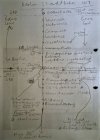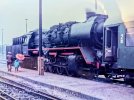What a vast range of oddities. There is a 1980s book "Berlin Transit", published by Thomas Cook and written by their Continental Timetable (and Modern Tramway principal contributor and tramway buff) John Price, which described it all at the time in technical, and traveller, detail. I went a couple of times then, and inevitably had some experiences the same, and some different, to the above.
Friedrichstrasse was indeed a useful transfer point between West systems, although physically in the East, you could get between them without needing the entry points. It was the interchange between U-Bahn U6, the North-South S-Bahn, and the westbound elevated S-Bahn. It was the best entry to East Berlin as well. Was interesting when back there just a few years ago to trace where all the dividers were now all the interchange passages are open. Apart from this, DDR "Intershops" operated right down on the U-Bahn platforms, selling to westerners goods that were commonly heavily taxed at somewhat under western prices, in "hard" currency, principally Deutschemarks but they also took Pounds and US Dollars. Mainly cigarettes, Marlboro seemed a principal brand, and in fact just as Perestroika opened up eastern Europe, and there was hyperinflation in Poland and elsewhere, a pack of 200 of these became a form of alternative currency. Proper western manufacture, not imitations.
East Berlin seemed to me better than portrayed, restaurants in particular gave those over the Wall a run for their money, likewise beer, and I always fully spent my DM25 converted to Ostmarks at 1:1, and later converted more. These places seemed in fact mainly used by DDR locals, but were familiar with tourists..
Come the end of The Wall in 1989 I was so fascinated that I nearly went, I had a plane flight identified but in pre-Internet days could not find a hotel, and didn't want to turn up on spec. But I went six months later and still have the quite sizeable chunks of demolished wall, not the tiny souvenir pieces, picked directly from the demolition sites. Surprisingly, even then the newly-merged DB seemed to be running (ex-DR) steam locos.
Even by this date much of the S-Bahn stock was still made up of pre-WW2 units, though extremely well maintained, with wooden seats varnished so well you tended to slip off them. Both east and west S-Bahn systems, though operated separately, had the same stock, which was interchanged between the two overnight. There was, in fact, a surprising amount of interchange continued between the two halves; all the West Berlin water supply came from the DDR.



